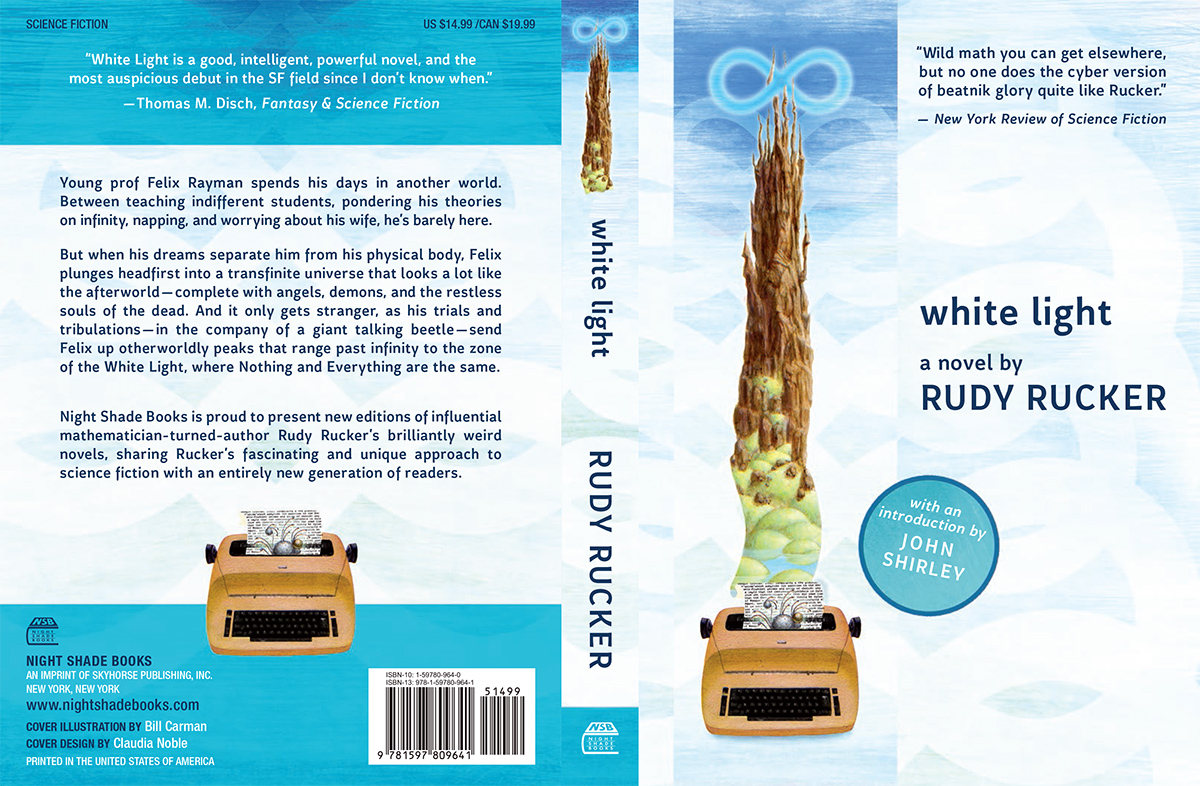|
White Light, by Rudy Rucker
White LightPaperback: Night Shade Books, March, 2019, 4th Edtion, with introduction by John Shirley. Paperback: Amazon. Browse free online as a webpage. SummaryA hipster math professor travels to the afterworld. Young prof Felix Rayman spends his days in another world. Between teaching indifferent students, pondering his theories on infinity, napping, and worrying about his wife he’s barely here. But when his dreams separate him from his physical body, Felix plunges headfirst into a transfinite universe that looks a lot like the afterworld—complete with angels, demons, and the restless souls of the dead. And it only gets stranger, as Felix's trials and tribulations—in the company of a giant talking beetle—sends up other-worldly peaks that range past infinity to the zone of the White Light, where Nothing and Everything are the same. MapWhite Light mentions an important map that the main character finds. Here's an image of that map.
ReviewsIn White Light Rucker commandingly synthesizes mysticism, pop imagery, the great mathematicians and their ideas, ‘head culture,’ and even voodoo into a novel that takes us on a wild journey to infinity, to the Absolute, and back again. As for sheer writing, there’s probably no one like him. — John Shirley, author of the Eclipse trilogy. White Light is a marvelously inventive and lunatically logical story, where not only is the scaling of infinity a mad, convincing adventure, but where ordinary human happiness matters too movingly. — Ian Watson in Vector. From the Author
Like Alwin Bitter of White Light, I was an assistant professor of mathematics at a state college in upstate New York from 1972 to 1978. I lost my job there, and spent two years as a visiting scholar at the University of Heidelberg, thanks to a miraculous grant from the Alexander von Humboldt Foundation. My research in Heidelberg was to be on Cantor’s Continuum Problem, an arcane question about levels of infinity. Early in 1979 I despaired of making any serious mathematical progress, and I wrote the novel White Light instead—followed by my novel Software in 1980. I had a very productive two years in Heidelberg. Underground comics were a major influence on White Light. I loved the sex, drugs, and countercultural humor of Zap Comix. Another influence was the early French parasurrealist author René Daumal. His strange, unfinished book Mount Analogue is about an expedition upon a mysterious mountain that unites Heaven and Earth. A final influence was Franz Kafka. I read all of Kafka’s journals while in Heidelberg. Kafka’s friend Max Brod once said that when Kafka read The Metamorphosis aloud to him, Kafka laughed so hard that he fell out of his chair. While I was writing White Light, I was also working on a nonfiction book called Infinity And The Mind, probably my best-selling book ever. In some sense both books are about the same thing: How can the human mind perceive the Absolute Infinite? If White Light leaves you hungry for more specific information about the science and philosophy of the infinite, check out the nonfiction version, that is, Infinity and the Mind, which will be out in a fourth edition from Princeton University Press in 2019. I still believe the basic premises of White Light: that cosmic One—or the Absolute, or the Big Aha—is a blinding white light which it is possible for a human to directly perceive, and that this ultimate entity is located at a nexus where Zero and Infinity are the same. When things get tough, I find it relaxing and uplifting to imagine that I’m merging with the One. Just like Felix Rayman, falling into the White Light. Not that have to believe anything in particular to enjoy my novel. It’s meant to be a fun, surreal run. |



